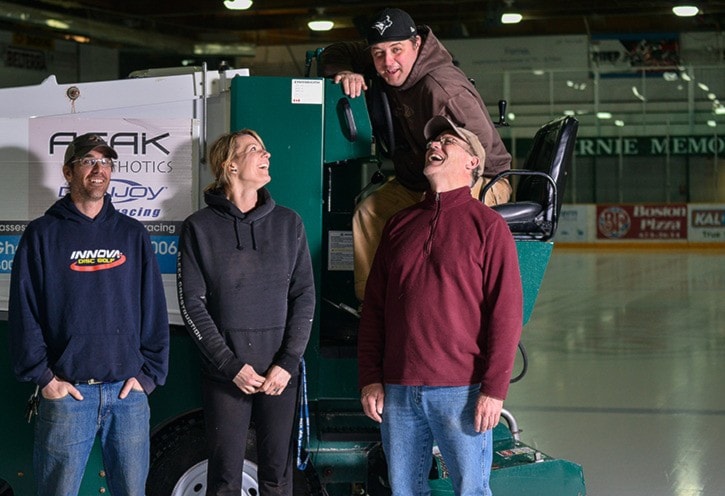Four individuals make hockey in Fernie possible, through their dedication in keeping the Fernie Memorial Arena alive and operational.
Serge Gosselin, Shaun Holder, Wayne Hornquist and Heather Lemmon make up the crew.
Gosselin has been around the valley for a while, and always wanted to work in the recreation side of Fernie. He also played hockey his whole life, and still does. Some may not know that he is a professional Frisbee player, and single-handedly built the Lizard Range Disc Golf Course. He has now been working at the arena full-time for five years.
“I’ve been around hockey my whole life, idolizing the Zamboni driver” said Holder, who has been in the city for 12 years, and working at the arena for nine.
The crew is employed by the City of Fernie, and work at the arena for eight months of the year. During the other four months, they take care of the parks. This includes edging fields, cleaning and repairing parks, tennis courts, ball fields, and special event set up.
In order to work at the arena, the crew must each obtain a refrigeration ticket, received after completing the B.C. Power Boilers Operators Certificate. This ensures they know everything there is to know about keeping the arena at the perfect temperature. Total certification includes three courses and one provincial exam.
Hornquist came to Fernie as an equipment operator, got the job in the arena, and has been doing it every since. This year marks his 25th year as a Zamboni driver, and arena caretaker.
“When you work in the rink, you have to do everything,” he said. “Clean up, maintenance, run the Zamboni, look after the refrigeration plant.”
Lemmon is the newest addition, with three years experience.
“I have to say, I never grew up around hockey or arenas, but working here, I’ve learned to love it,” she said.
For Hornquist, the most challenging part of the job is maintaining ice levels and condition.
Many factors come into play when assessing quality of ice, and maintaining it to a good standard. Twice a week, the crew measures the depth of the ice. They try to maintain an inch and a quarter depth.
A 15-minute timeframe is allocated between user group, where the crew will flood and shave the ice, trying their best to give each group just as good a quality as the last. This can sometimes be a challenge, as figure skaters like soft ice, where as hockey players like hard ice. At the end of the night, the crew will take much longer to clean up and prepare for the next day.
Corners may need to be shaved or edged, and the ice may be flooded several times.
Temperatures outside and inside play a large role in the ice condition. An extremely cold day/evening of -30 could make the ice brittle. If it’s too warm, the ice will turn to mush. The crew tries to maintain the ice between minus eight and minus six degrees celsius.
During the winter season, the Fernie Memorial Arena is a busy place. It is commonly occupied by people from six in the morning until midnight. Every ice related activity takes place here. From figure skating, to junior B hockey, to men’s league hockey and women’s hockey.
Throughout Hornquist’s 25 years in the arena, hockey has changed significantly, mostly because of numbers of children. In the early 70s, the Fernie Figure Skating Club had 175 members. Fernie Minor Hockey had upwards of 350. He is unsure as to whether the arena will ever see those kinds of numbers again, because there’s so many more things to do in Fernie now.
“Back in those days, you either played hockey, you skied or you were a figure skater,” he said. “There were no people cross country skiing, snowshoeing... It’s changed.”
He believes the main reason this has changed is because of the influence and introduction of tourism, in the late 90s. Also, when the mines switched to four-and-four shifts, this took a hit on sports and activities. Before this, everyone had weekends off, which resulted in higher attendance at games.
When Holder was playing minor hockey, Hornquist was maintaining the ice.
This year, April 22 is the last day the refrigeration plant is in operation, and will fire up again during the first week of August. At this point, the ice will be taken out, which can take two to three days. It can take six to seven days to put it back in properly.
Every line under the ice is hand-painted.
In larger centres, there may be dedicated Zamboni drivers, ice shavers, janitors, etc. In Fernie, four members share all responsibilities.
